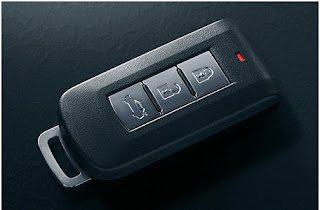One of the most important lessons to learn about off-road driving is that the aim should be to get to your destination without damage to the vehicle, the land, or yourself. Don't think of it as a speed trial - steady, careful progress is always best.
Engage 4WD as soon as you leave the road. A Mitsubishi in 2WD will easily cope with gentle off-road terrain, but in 4WD there's less chance of being caught out by surfaces that are much more slippery than they look. Wet grass, for instance, can be treacherously slippey. And in 4WD there will be less wheelspin - and so less chance of damage to the ground.
Before you attempt to cross any serious terrain, get out and take a close look at the land - you'll learn a lot about it. How soft is the mud, how steep are the hills, how deep is the water, how many rocks are there? Knowing all this will be a big help when planning and driving the route.
Engaging Low Ratio When you encounter mud, slopes, rocks and generally extreme conditions, that's the time to engage low ratio. You're unlikely to get through without it.
Soft deep mud, for example, sucks the vehicle down and places such a drag on the engine that there's a real chance you'll stall if still in high ratio. But in low, engine revs will be higher, therefore giving the vehicle a much better chance of powering through the quagmire.
The benefit of low ratio when negotiating rocks or extremely uneven surfaces is that it allows the vehicle to creep forward without the need to slip the clutch.
Rear Differential Lock
Various Mitsubishi 4x4s have a lockable rear differential, and this can help in extreme conditions when not even 4WD low ratio is enough. Because the diff lock gives side-to-side locking on the rear axle, it's particularly useful when one of the rear wheels loses traction, say when crossing a ditch at a diagonal angle. Normally the drive would disappear out of the spinning wheel, but with the lock on you can keep moving provided one rear wheel has traction.
Descending Steep Slopes
For those with no 4WD experience, the technique for steep hill descent can be daunting, but with care it's really quite easy. Line the vehicle up with the path of descent, ensure first gear low ratio is engaged, and drive the vehicle very slowly over the brow of the hill. Once the descent begins, on all but the steepest slopes you need to do nothing more than steer, as the low gearing combined with engine braking should lower you slowly down the slope.
Should you find yourself needing to use the brakes, extreme caution is necessary to ensure you don't brake so hard as to stall the engine or send the vehicle into a slide. And should you find yourself on a slope so slippery that the vehicle is travelling faster than the wheels are rotating, you will need to accelerate to regain steering control.
But braking and accelerating on hills are two difficult techniques to master, and two good reasons to stick to less ambitious slopes until you've gained the necessary skills.
Hill Climbing
The successful ascent of a steep incline involves traction, momentum, and a steady throttle foot. And as with the downhill descent, keep the vehicle as straight as possible. Low ratio is a must and second gear is usually the best choice unless the hill is really steep (if you're driving an automatic 4x4, keep the selector in low). The gear you start off in is the one you'll stay in. To maximise momentum, approach the slope at a brisk pace, but not so fast as to risk the front bumper digging into the ground at the point where the incline begins.
Reversing Back Down
As soon as it becomes clear you aren't going to make it to the top of the hill, you need to get into a position where you can easily and safely get back down to the bottom so that you can try again. Lift off the accelerator and apply the footbrake and clutch, which should hold the vehicle steady. Then select reverse. Release the brake and clutch together, and allow the vehicle to descend, using engine braking alone (you will of course still be in low ratio). Keep both hands on the wheel and make sure you're backing down square on to the hill, because if you stray off line the vehicle could end up sideways across the course, which could in extreme circumstances result in it rolling over.
The procedure for automatic 4x4s is similar. At the point of ascent 'failure', brake, let the revs die, select 'R' and reverse down. If in a manual vehicle if you stall the engine, don't panic. Brake, select reverse, and with the clutch engaged gently lift you foot off the brake; at this point gravity might take over, the backward movement bump-starting the engine. If not, with no feet on any pedals briefly turn the starter and that should get you moving.






























































0 comments